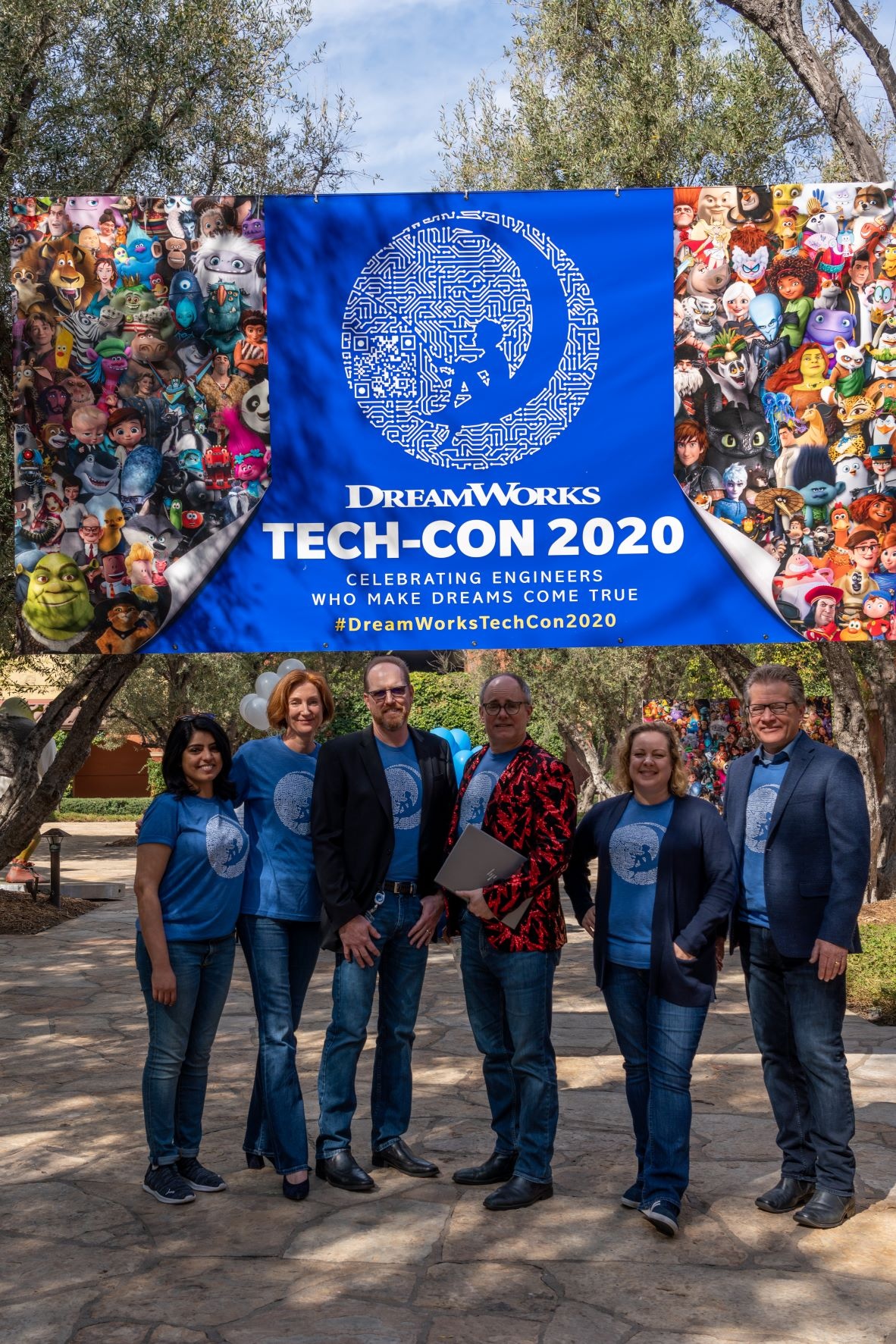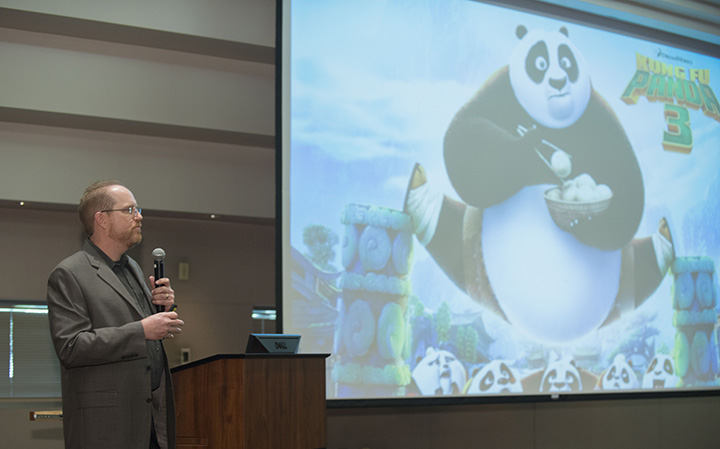Computer Science Grad Bill Ballew Follows His Passion as DreamWorks Animation CTO

When Cal State Long Beach computer science graduate Bill Ballew went to work for a startup, he saw an opportunity to connect two of his passions—computers and animation. Twenty-five years later, that startup, DreamWorks Animation, is now owned by NBCU/Comcast, the second-largest broadcasting and cable television company in the world. And after rising in the ranks from software engineer to executive, Ballew was recently named CTO.
In his previous role as Vice President of Research and Development, Ballew (’91) oversaw a team of about 100 software engineers with expertise in microservices, rendering, full-stack web development, configuration management, and FX simulations.
“The group that I was in charge of is responsible for the vast majority of software used in the studio—large-scale proprietary tools built from the ground up, extensions to third-party tools to enhance artist workflows, and infrastructure that our production pipeline is built on top of,” Ballew said.
In his new position, he’s moved up a level, and is responsible for the company’s vision and long-term technology strategy. That entails overseeing all of DreamWorks engineering and operations divisions, including production software, digital operations, network and storage infrastructure, info security, and strategic partnerships.
DreamWorks Animation typically has 3-5 films in production at any given time, each taking 3-4 years to produce. And while its creative franchises are well-known–including Shrek, Trolls, Kung Fu Panda, and How to Train Your Dragon—not everyone is familiar with the technology required to produce those films.
The operation’s digital requirements are impressive: 800 physical servers, 200 database clusters spanning 15 types of databases, a 52,000-core render farm that expands to 75,000 cores at night, and 13 petabytes of storage. Just one film requires about 120 million core hours to generate the final rendered images. With that level of compute, the infrastructure needs to scale and can support 400,000 NFS operations per second.
The scale is on par with the defense or oil and gas industries, but due to the nature of its work, DreamWorks has more freedom to innovate.
“We’re a little more willing to take on risk. The ramifications of trying something new aren’t as great as they are with some of those other industries,” Ballew said. “In our case, we can push boundaries and experiment, and the worst that may happen is we don’t get a good render of Shrek. But the best that can happen is that we embrace innovations that significantly accelerate creative and business outcomes.”
DreamWorks’ culture of innovation is attractive to its strategic partners—currently DXC, Lenovo, Microsoft, and NetApp. “We partner with cutting-edge technology companies to accelerate our engineering initiatives needed for our business ambitions,” Ballew said.
Collaborations with strategic partners and other vendors cultivate knowledge sharing, as does the annual tradeshow SIGGRAPH, where research is shared on difficult challenges facing the industry. Ballew said one area of continued research is hair, fur, and fuzz, which represented unique challenges in creating the characters and environments in the Trolls franchise.
Ballew said the future of DreamWorks data and services is in fully leveraging a true hybrid- cloud. The company is rolling out a new cloud-native pipeline that will work in concert with on-premises infrastructure —essentially managing the complex assembly line of data as it passes from one artist workflow to the next. With a half-billion files for each film, making sure artists have the correct version of each file is critical.
Like many companies, DreamWorks is focused on improving the diversity, equity, and inclusion of its workforce. “The technology and software industry is behind when it comes to diversity,” Ballew said. “Across the board, it’s challenging, but we have a significant effort internally to improve that.”
He said efforts are underway to retain diverse hires, recruit from schools with diverse student bodies, and spread the word about entertainment technology. “The animation and VFX industry is all about the confluence of art and technology. The technology teams work hand in hand with the creative teams to accomplish what we see on the screen.”
A longtime fan of animation, Ballew joined DreamWorks when computer animation was in its infancy. He’d worked after graduation at The Aerospace Corp. and Trident Data Systems, but was increasingly captivated by the computers being used for animation in Disney films such as The Little Mermaid (1989) and Beauty and the Beast (1991).

“You started to see ink and paint being done digitally and even some of the first characters being computer generated,” Ballew said, recalling the dancing forks and spoons in Beauty and the Beast.
On a whim, he submitted a resume to DreamWorks, which was being backed by director Steven Spielberg (’01), former Disney executive Jeffrey Katzenberg, and music executive David Geffen. He was hired as a software engineer.
Ballew’s earliest computer experience was in the 1980s with a high school Apple II lab and an Atari 2600 game system with a programmable BASIC cartridge. “I got in early. I was a member of the computer club, and decided that’s what I wanted to do.”
His parents supported his decision, although Ballew said they wondered, “What kind of career is that going to be?”
At CSULB, his classes started off in FORTRAN and Pascal and soon moved to C/C++. Faculty who provided mentorship included Sheila Foster, who taught an operating systems class in C with Unix; former COE Dean Mike Mahoney, who taught computer graphics; and current CECS Professor Shui Lam, who taught algorithms. He was a member of honor societies, and part of the first set of Alumni Scholars (later becoming the President’s Scholars).
Ballew urges current students to discover their passion. “Determine what you really enjoy and follow it. The path may not always be direct. It may be a circuitous route. But that’s the only way you’re going to be happy in your career.”
Many companies, including DreamWorks, offer internships. The DreamWorks internship program, Ballew said, “definitely provides a real-world experience that is not about getting coffee or running errands. You’re in the code. You’re working with our teams. You’re going to produce something that will make a difference for our artists.”
At DreamWorks, interns also have a chance to work with people with different sensibilities. “Our artists often look at problems from a different perspective than we do as engineers. Learning how to collaborate and bridge that gap is crucial in allowing us to create better software solutions.”
Ballew also suggests contributing to open source communities in hard-to-break-into industries like animation and visual effects. In the entertainment industry, the Academy Software Foundation (ASWF) is one example.
“There are many opportunities to contribute to open source projects. Starting with writing unit tests or documentation can be a great way to learn. It looks amazing on a resume. If you’ve been collaborating on an open source project that we rely on in the studio, that’s a huge foot in the door,” he said. “Be persistent and don’t give up. If there’s not an open door right now, come back to it and see if someone has unlocked it.”





